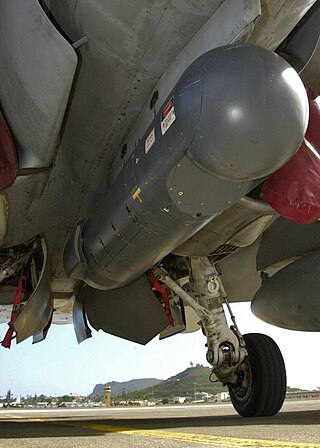
The Tactical High-Energy Laser, or THEL, was a laser developed for military use, also known as the Nautilus laser system. The mobile version is the Mobile Tactical High-Energy Laser, or MTHEL. In 1996, the United States and Israel entered into an agreement to produce a cooperative THEL called the Demonstrator, which would utilize deuterium fluoride chemical laser technologies. In 2000 and 2001, THEL shot down 28 Katyusha artillery rockets and five artillery shells. On November 4, 2002, THEL shot down an incoming artillery shell. The prototype weapon was roughly the size of six city buses, made up of modules that held a command center, radar and a telescope for tracking targets, the chemical laser itself, fuel and reagent tanks, and a rotating mirror to reflect its beam toward speeding targets. It was discontinued in 2005.

The Boeing YAL-1 Airborne Laser Testbed weapons system was a megawatt-class chemical oxygen iodine laser (COIL) mounted inside a modified military Boeing 747-400F. It was primarily designed as a missile defense system to destroy tactical ballistic missiles (TBMs) while in boost phase. The aircraft was designated YAL-1A in 2004 by the U.S. Department of Defense.

Northrop Grumman Corporation is an American multinational aerospace and defense technology company. With 90,000 employees and an annual revenue in excess of $30 billion, it is one of the world's largest weapons manufacturers and military technology providers. The firm ranks No. 101 on the 2022 Fortune 500 list of America's largest corporations.

A laser designator is a laser light source which is used to designate a target. Laser designators provide targeting for laser-guided bombs, missiles, or precision artillery munitions, such as the Paveway series of bombs, AGM-114 Hellfire, or the M712 Copperhead round, respectively.

The Oerlikon/Martin Marietta Air Defense Anti Tank System is a dual-purpose short range surface-to-air and anti-tank missile system based on the M113A2 vehicle. The ADATS missile is a laser-guided supersonic missile with a range of 10 kilometers, with an electro-optical sensor with TV and Forward Looking Infrared (FLIR). The carrying vehicle also has a search radar with an effective range of over 25 kilometers.

The Missile Defense Agency (MDA) is the section of the United States government's Department of Defense responsible for developing a layered defense against ballistic missiles. It had its origins in the Strategic Defense Initiative (SDI) which was established in 1983 by Ronald Reagan and which was headed by Lt. General James Alan Abrahamson. Under the Strategic Defense Initiative's Innovative Sciences and Technology Office headed by physicist and engineer Dr. James Ionson, the investment was predominantly made in basic research at national laboratories, universities, and in industry. These programs have continued to be key sources of funding for top research scientists in the fields of high-energy physics, advanced materials, supercomputing/computation, and many other critical science and engineering disciplines—funding which indirectly supports other research work by top scientists, and which was most politically viable to fund within the Military budget of the United States environment. It was renamed the Ballistic Missile Defense Organization in 1993, and then renamed the Missile Defense Agency in 2002. The current director is U.S. Navy Vice Admiral Jon A. Hill.

The AN/AAQ-28(V) Litening targeting pod is an advanced precision targeting pod system currently operational with a wide variety of aircraft worldwide. The research and development of the Litening was first undertaken by Rafael Advanced Defense Systems' Missiles Division in Israel, with subsequent completion of Litening I for use in the Israeli Air Force.
Thiokol was an American corporation concerned initially with rubber and related chemicals, and later with rocket and missile propulsion systems. Its name is a portmanteau of the Greek words for sulfur and glue, an allusion to the company's initial product, Thiokol polymer.

The Oerlikon GDF or Oerlikon 35 mm twin cannon is a towed anti-aircraft gun made by Oerlikon Contraves. The system was originally designated 2 ZLA/353 ML but this was later changed to GDF-001. It was developed in the late 1950s and is used by around 30 countries.
A chemical laser is a laser that obtains its energy from a chemical reaction. Chemical lasers can reach continuous wave output with power reaching to megawatt levels. They are used in industry for cutting and drilling.

A laser weapon is a type of directed-energy weapon that uses lasers to inflict damage. Despite decades of research and development, as of January 2020, directed-energy weapons, including lasers, remain at the experimental stage. Whether they will be deployed as practical, high-performance military weapons remains to be seen. One of the major issues with laser weapons is atmospheric thermal blooming, which is still largely unsolved. This issue is exacerbated when there is fog, smoke, dust, rain, snow, smog, foam, or purposely dispersed obscurant chemicals present. In essence, a laser generates a beam of light that requires clear air or a vacuum to operate.

An infrared countermeasure (IRCM) is a device designed to protect aircraft from infrared homing missiles by confusing the missiles' infrared guidance system so that they miss their target. Heat-seeking missiles were responsible for about 80% of air losses in Operation Desert Storm. The most common method of infrared countermeasure is deploying flares, as the heat produced by the flares creates hundreds of targets for the missile.
The GBU-44/B Viper Strike glide bomb was a GPS-aided laser-guided variant of the Northrop Grumman Brilliant Anti-Tank (BAT) munition which originally had a combination acoustic and infrared homing seeker. The system was initially intended for use from UAVs, and it was also integrated with the Lockheed AC-130 gunship, giving that aircraft a precision stand-off capability. The Viper Strike design is now owned by MBDA.

The Northrop Grumman Bat is a medium-altitude unmanned air vehicle originally developed for use by the United States Armed Forces. Designed primarily as an intelligence "ISR" gathering tool, the Bat features 30 lb (14 kg) payload capacity that is unmatched in a 10 ft (3.0 m) wing span.

The Saudi Arabian Air Defense Forces or officially Royal Saudi Air Defense Forces (RSADF) is the aerial defense service branch of the Saudi Arabian Armed Forces. It is fourth of the five service branches of the MOD. It has its HQ in Riyadh, where there is also an elaborate underground command facility that co-ordinates the Arabian Kingdom's advanced "Peace Shield" radar and air defense system, with an estimated 40,000 active duty military personnel in 2015. Along with the Royal Saudi Air Force (RSAF), it has responsibility for securing the skies of Saudi Arabia.
Flight Guard is an Elta Systems Ltd's brand name for a family of airborne systems for protecting civilian aircraft against man-portable air-defense systems.

The Northrop Grumman Guardian is a passive anti-missile countermeasure system designed specifically to protect commercial airliners from shoulder-launched missiles, using directed infrared countermeasures (DIRCM) technology.
The Space Tracking and Surveillance System (STSS) was a pair of satellites developed by the United States Missile Defense Agency (MDA) to research the space-based detection and tracking of ballistic missiles. Data from STSS satellites could allow interceptors to engage incoming missiles earlier in flight than would be possible with other missile detection systems. The STSS program began in 2001, when the "SBIRS Low" program was transferred to MDA from the United States Air Force. In December 2002, SBIRS Low Research & Development was renamed Space Tracking and Surveillance System (STSS).

Iron Dome is a mobile all-weather air defense system developed by Rafael Advanced Defense Systems and Israel Aerospace Industries. The system is designed to intercept and destroy short-range rockets and artillery shells fired from distances of 4 kilometres (2.5 mi) to 70 kilometres (43 mi) away and whose trajectory would take them to an Israeli populated area. From 2011 to 2021, the United States contributed a total of US$1.6 billion to the Iron Dome defense system, with another US$1 billion approved by the US Congress in 2022.
Northrop Grumman Innovation Systems (NGIS) was a sector of Northrop Grumman from 2018 through 2019. It was formed from Orbital ATK Inc. a company which resulted from the merger of Orbital Sciences Corporation and parts of Alliant Techsystems in 2015. Orbital ATK was purchased by Northrop Grumman in 2018. Northrop Grumman Innovation Systems designed, built, and delivered space, defense, and aviation-related systems to customers around the world both as a prime contractor and as a merchant supplier. It had a workforce of approximately 12,000 employees dedicated to aerospace and defense including about 4,000 engineers and scientists; 7,000 manufacturing and operations specialists; and 1,000 management and administration personnel. With Northrop Grumman's reorganization of its divisions effective January 1, 2020, NGIS was split, with most of the sector merging with other Northrop Grumman businesses into a new Space Systems sector.












